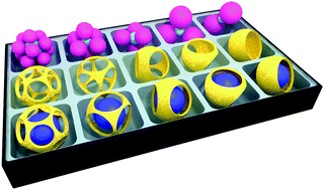C. Hubert, C. Chomette, A. Désert, A. Madeira, A. Perro, I. Florea, D. Ihaiawakrim, O. Ersen, A. Lombardi, E. Pertreux, F. Vialla, P. Maioli, A. Crut, N. Del-Fatti, F. Vallée, S. Mornet, J. Majimel, S. Ravaine, E. Duguet, and M. Tréguer-Delapierre
Nanoscale Horizons, 2021, DOI: 10.1039/d0nh00620c
Highly symmetrical gold nanocages can be produced with a controllable number of circular windows of either 2, 3, 4, 6 or 12 via an original fabrication route. The synthetic pathway includes three main stages: the synthesis of silica/polystyrene multipod templates, the regioselective seeded growth of a gold shell on the unmasked part of the silica surface and the development of gold nanocages by dissolving/etching the templates. Electron microscopy and tomography provide evidence of the symmetrical features of the as-obtained nanostructures. The optical properties of nanocages with 4 and 12 windows were measured at the single particle level by spatial modulation spectroscopy and correlated with numerical simulations based on finite-element modeling. The new multi-step synthesis approach reported here also allows the synthesis of rattle-like nanostructures through filling of the nanocages with a guest nano-object. With the potential to adjust the chemical composition, size and geometry of both the guest particle and the host cage, it opens new routes towards the fabrication of hollow nanostructures of high interest for a variety of applications including sensing devices, catalytic reactors and biomedicine.







